From the early 1830’s patients and beds go hand in hand at the hospital over the 174 years of operation and the styles have changed over that time. In the 1830s, due to a critical shortage of beds, the District Surgeon Dr. Officer ordered iron beds from NSW (50 arrived) along with permission to make more iron beds on site. This type of bed was used at Willow Court until the 1960s ref: (‘Troubled Asylum’, Gowlland,1981, p13-14).
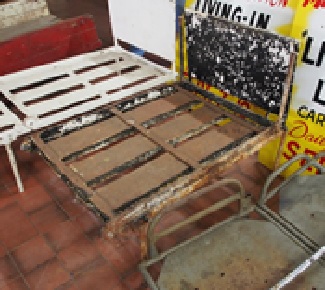
This bed could be folded in half for easy storage and transportation. The picture below shows what was commonly used as a mattress right up to the 1960’s.
‘There was no mattresses or rubber beds; they were all straw, every bed was straw and you had to go out and fill these jolly things. When they go flattened a bit, you know; when they started to get comfortable … you had to go and fill them up again’.
(ref: June Purkiss, ‘Living In Living Out’ exhibition). 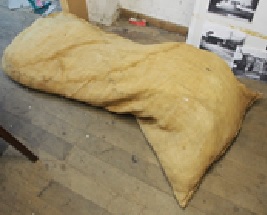
The next style is a bit of a mystery as to the time it was used in the hospital. This clever style could also convert into a seat. It is thought it could’ve been used in the 1900th century. It is a folding, tubular metal bed (chair) with side rails with an adjustable head height. Fabric strips tie the metal base to headboard.
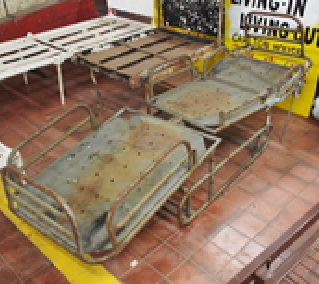
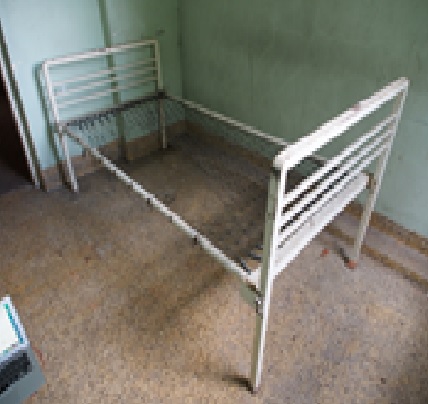
Not dissimilar to the Port Arthur patterned bed but built with modern white square tubular steel and a wired spring base. This late 20th century bed was used throughout the hospital. Similar beds are seen in a 1970’s photo of a dormitory at the Royal Derwent Hospital, taken for display in the Tasmanian Agent General’s Office, London.
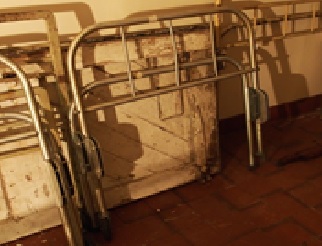
The bed base is missing from this round aluminium tubing headboard with 3 vertical struts and footboard. Similar beds are seen in a 1970s photo of a crowded dormitory in the Royal Derwent Hospital, taken for display in the Tasmanian Agent General’s Office, London. In the photo, round tubing framed beds like this alternate with square tubing framed beds (above photo). (Ref: Archives Office of Tasmania AA193-1-291)
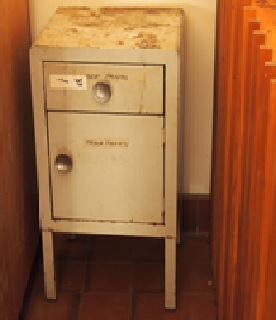
A bed wouldn’t be complete without a bedside table like this one. This cream metal bedside cabinet with a single drawer and door is marked with ‘under pants’ written on masking tape on the drawer and ‘track pants’ on the door. The Acne beds name plate is on the rear.
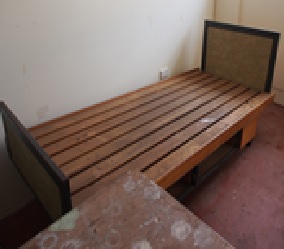
This late 20th Century wooden and steel framed bed has two drawers under the bed and had a mottled green vinyl on the headboard and footboard. There is one of these in C ward but it is in poor condition.

This ‘Hendicare’ adjustable brown metal framed bed has a metal grid base and is on casters. It has flexible pull out mesh on one side of the frame and melinex footboard slots into the base. Most likely dating from the late 20th century.
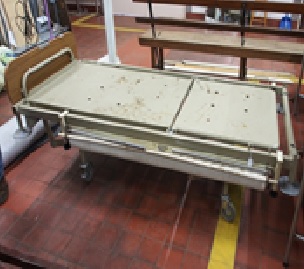
Another modern bed, this adjustable steel bed, on casters has a pull out flexible mesh sides and wood grained plastic laminate headboard. Manufactured in Australia by Siltex Engineering Pty. Ltd. Patent No. 544268, it was supplied by Joyce Hospital Equipment, c.1970-1980s.
Lastly this Child’s metal cot with adjustable height base. Similar cots are seen in a 1970s photo of a children’s dormitory in the Royal Derwent Hospital, taken for display in the Tasmanian Agent General’s Office, London.
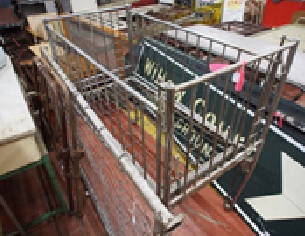
2 Comments
Hello. I have recently moved to NN and would like to join your society group. My name is Sandra Saal.
Hi Sandra,
Thanks for your offer, I have sent a private email with contact details. If that is what you are looking for and meets your thoughts, otherwise pleas get back to me as I am planning a research group who would put together the history of the site in a much more detailed manner.
Cheers
Mark